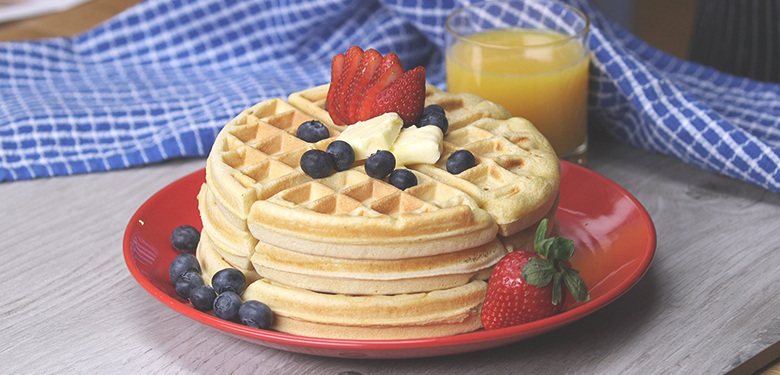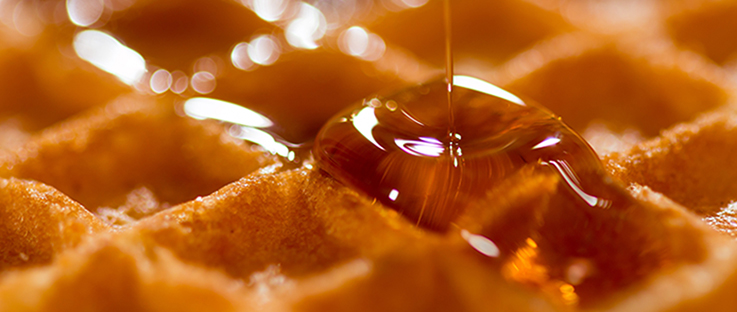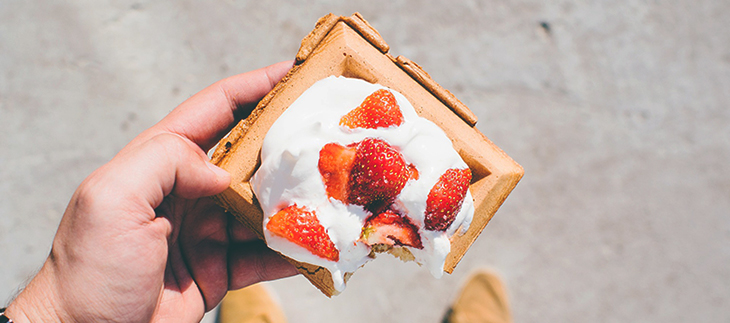
Synonymous with Europe and a Belgian culinary speciality, the waffle is an extremely popular menu item across all of continental Europe and has transcended oceans to become something of a cultural institution in North America.
Here, however, it’s more of a foreign delight; one that becomes increasingly more prominent during the winter months when festive markets roll into town.
The Waffle’s recipe is relatively simple and straightforward.
All that’s needed is some milk, eggs, flour and a pinch of salt – yes, that simple.
However its composition is much more complex than that: In Belgium, the heartland of the waffle, each region and city has its own unique take on the waffle, with The Nibble stating that prominent ‘points of departure include yeast, caramelised sugar, leavenings and fillings or toppings.’
We’ve not even mentioned the ice cream cone yet, which is a direct descendent of the waffle that has its very own complicated origin story.
Like all the best things in life, waffles can be unique, with their evolution shrouded in mystery, intrigue and passed down the generations like a priceless family heirloom.
Humble Beginnings
At least for the waffle, it all began as a basic version of a flat cake.
This simple mixture of pulped cereal was heated on rudimentary cooking devices for varying times.
But as technology advanced, so too did cooking techniques, although for years this basic recipe remained.
But by the time of the Ancient Greek Empire the mixture had altered somewhat, but by no means substantially. Referred to as obleios, these early waffles were often savoury and served, and flavoured, with cheese and herbs.
However, during the Middle Ages, there was a true waffle revolution.
Nobody knows exactly when, but at one point in history somebody* had the truly inspired idea of forging together a couple of cooking plates. Fitted with ornate etchings, these irons gave the waffle its name – for you see waffle is derived from gaufre and in turn wafla, a term referring to “a piece of a honeybee hive.”

Eaten by all sections of society, from the Royalty to the peasantry, the waffle became a popular food of choice for much of continental Europe.
Such was its prominence, King Charles IX of France had to introduce a code of practice to waffle sellers.
This occurred as an attempt to quell some fracases that surrounded waffle sellers jostling for prime positions in Paris and other major cities during the 1600s.
Ever-changing recipe
But during this period we saw a major waffle schism.
The upper classes could rely on their waffles being made from the finest ingredients such as egg, milk and honey.
Whilst those who were less privileged had to make do with ingredients of a sub-standard quality.
Recipes began to become malleable and the foodstuff transformed from a standardised entity to one that was dictated by class, location and wealth.
No wonder then that in Belgium alone there are a myriad of geographically influenced versions of the waffle.
And then, America happened.
A staple of breakfast diners all across the United States, the waffle has, actually, enjoyed two debuts on the other side of the Atlantic.
The first foray being in the 1600s and the second, perhaps the more famous instance, occurring in 1964.
The World Fair
Though they’d been enjoyed in North America for centuries prior to 1964, the New York World’s Fair really helped reinvent waffles and turn them into something of a culinary institution.
There was something special about this batch that captured the attention of The Big Apple; the Maurice Vermersch utilised a family recipe and mixed that, quite literally, with a bit of marketing genius.
The recipe and cooking method came from Brussels, as did the way they were to be consumed: without the use of cutlery.
Marie Paule Vermersch, the daughter of Maurice, claims that her mother shunned customers away from picking up knives and forks.
Instead, actively forcing people to tuck into their waffles with their hands.

But, as Maurice knew, the trick was to produce a commodity.
Aware that many Americans were unfamiliar with Brussels, he sold his waffles as being ‘Belgian’.
This fast and loose christening worked wonders and the waffle became instantly recognised as the ‘Belgian Waffle’.
It is believed that the Pilgrims brought the waffle over from the Low Countries when they emigrated to The New World and met their perfect match in maple syrup.
Food fit for the President
Much like their history in Europe they were loved and devoured by people from all walks of society.
The Oxford Encyclopaedia of Food and Drink in America recounts that waffles were ‘common fare’ in the mining camps and tent towns that popped up during the American Gold Rush.
And if rumours are to be believed, none other than Thomas Jefferson, the 3rd President of the United States, was said to be a huge fan.
It’s even rumoured that he was the first person to bring a traditional long-handled waffle iron to America in 1789.
Between the late-1800s and the mid-1900s waffles were immensely popular in the States.
The first electric waffle iron was patented on August 24th 1869, and as the years went by numerous different recipes and products sprung up to take residence in cookbooks and on the shelves.
But with all this expansion the traditional roots of the waffle got lost.
And having allowed Maurice Vermersch to reinvent the wheel and muscle in with his European-influenced waffle we’re now at the apex of the batter-based treat.
Waffle types
- Brussels waffle: It is claimed the Brussels waffle is the original. This light and crispy waffle has deep honeycomb pockets and is traditionally served with a light dusting of sugar.
- Liege waffle: Rumoured to be invented by the prince-bishop of Liege in the 1400s, the Liege waffle is smaller and denser than the Brussels waffle and contains pearl sugar. Has a sweet flavour.
- American waffle: Where the Belgian waffles use yeast, the American waffles use baking powder. Perfectly multifunctional, these varieties can be used in both sweet and savoury dishes.
